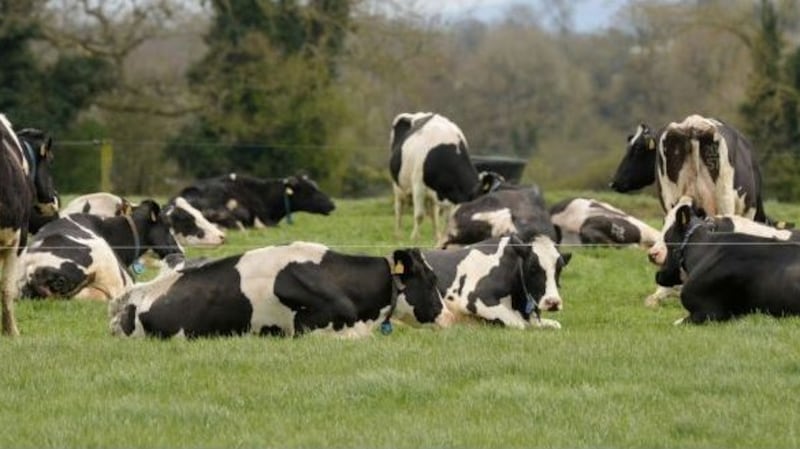Along with tampons, kids’ shoes and solar panels, chemical fertilisers have a VAT rate of zero per cent. We’re a bit of an outlier in Europe in applying this zero rate for fertilisers, but the argument goes that raising the price of a bag of 10-10-20 wouldn’t be any good; after all, without fertilisers, farmers couldn’t possibly grow enough grass and crops to stay in profit, could they?
Farmers are certainly sensitive to fertiliser prices, as was evident in 2022 when Russia invaded Ukraine. Fertiliser isn’t made here, so the companies that sell it – including dairy co-operatives – import it; two years ago, up to 40 per cent was sourced from Russia. Disruptions in natural gas supplies after the war began led to soaring fertiliser prices, and what had cost about €350 a tonne before the invasion rocketed to €1,200.
In response to this price surge, farmers reduced their use. For some, pulling back from fertiliser is like facing a kind of addiction; it’s hard to fathom life without it, and in many ways that’s understandable. In the years leading up to the lifting of dairy quotas in 2015, the specific expansion model adopted by Teagasc (our publicly funded State agency for agri-food research) included a near-total dependence on it for fields of monoculture ryegrass. This grass species won’t grow to full capacity without fertiliser, which costs farmers thousands – sometimes tens of thousands – each year.
Spreading fertiliser on grass is the equivalent of giving steroids to a 100 metre sprinter. It’s incredibly effective at boosting growth but, as scientists have long pointed out, chemical fertilisers are potent pollutants. Manufacturing them takes an eye-watering amount of energy, releasing vast quantities of greenhouse gases into the atmosphere. These emissions continue when the fertilisers are spread on fields, which can also damage air, soil and water quality.
This ‘Irish Whale’ has been spotted off Donegal and the coast of North America
Let’s be ambitious for a plan to establish a real record of the majestic Shannon’s condition
An extraordinary find in the Irish Sea left experts gobsmacked
The golden plover’s numbers in Ireland have dwindled to a few isolated strongholds
The agriculture sector has just over five years left to cut emissions by 25 per cent on 2018 levels. Anyone who can count knows that this target won’t be reached, but what’s clearly proven is that cutting fertiliser reduces emissions. In July the Environmental Protection Agency reported that agriculture emissions had decreased by 4.6 per cent since the previous year, “primarily due” to an 18 per cent drop in fertiliser use.
Can farmers move to a low-to-no fertiliser model while maintaining profits? The answer is found underground in tiny nodules on the roots of clover plants, where soil bacteria pull nitrogen from the air and convert it into fertiliser, which surrounding plants use to grow. This natural process doesn’t cause greenhouse gas or ammonia emissions, and clover is a firm favourite of insects such as wild bee species – 30 per cent of which face extinction here within a few years.

If clover is to work for conventional, intensive and non-organic farmers, only one question matters: Can a farm with clover fields but little to no chemical fertiliser grow enough grass to feed the cows and maintain profit?
For the past two decades, this has been the question asked by a small, under-the-radar team of Teagasc scientists in Solohead research farm in Tipperary. Earlier this month, on the back of four years of work there, dairy farmer and academic Owen Cashman and his colleagues published a paper in a highly reputable international journal that included some remarkable results: by swapping chemical fertiliser for clover, the same amount of grass can be grown, farm profitability can be maintained (and possibly improved), and greenhouse gas emissions can be reduced by 21 per cent per hectare.
[ How to achieve farming sustainably in a globally connected worldOpens in new window ]
None of this can happen instantly. Establishing a grass management system reliant on clover rather than chemicals takes up to 10 years. And there’s no magic bullet for grass growth; not even a tonne bag of fertiliser bought in the local co-op will work if the biggest determinant, the weather – increasingly erratic and unpredictable because of climate change – isn’t right. Still, Cashman’s research suggests that clover is a viable alternative for farmers who want to stay in profit and deal positively with the environmental challenges they face.
But some parts of Teagasc, notably Moorepark in Cork, home to its dairy and grass research, appear somewhat restrained in their advice. Earlier this year a booklet about clover included a recommendation to spread quantities of fertiliser when clover is seeded in the ground, which is at odds with other research indicating that clover won’t bother to make its own natural fertiliser if the chemical alternative is spread over it.
Ireland faces billions of euro in fines, paid for with public money, if we don’t meet our emission reduction targets. In 2022 Irish farmers spent €1.2 billion on fertiliser alone. Why do this if the research shows there’s a cheaper, nature-friendly alternative – one that will help slash emissions while keeping the farm viable for future generations?
If the only cost of moving towards low-to-zero fertiliser is a cut in the profits of the fertiliser companies, for the sake of our land, our farmers and, quite frankly, the future of our planet, then surely that’s a price worth paying.













